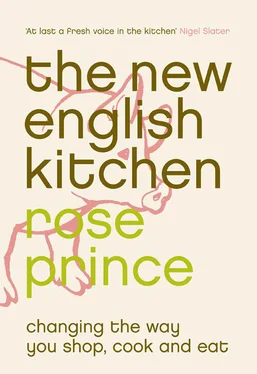The life of a good loaf of bread could unfold in the following way. On day one, it is as fresh as can be, the interior deliciously elastic and the crust crisp as an eggshell. A day or two later the crumb begins to dry, the crust to soften, and it’s good for toast. Toast brushed with flavoured oil, then topped with salad leaves and soft fresh cheese; toast with creamy scrambled egg and marinated fish; or, best of all, toast spread with real beef dripping from yesterday’s roast. Next day, put a slice of the now drying bread into a bowl and ladle over some vegetable broth. Or, if you are having a supper party, you might use the bread to make a toffee pudding or a fruit charlotte. By the end of the week, anything left from the loaf can be made into breadcrumbs. Eat them spiked with lemon zest beside roast poultry or game; mix them with garlic, herbs and olive oil for stuffing vegetables; or store them in the freezer for bread sauce. By now, I think it would be safe to say your loaf has earned its keep. You bought it to make a sandwich and it has contributed to at least four meals.
The economics of bread have an interesting pattern. A loaf of sliced, wrapped bread costs about 50 pence – although supermarket price wars have seen it drop down to 20 pence as a ‘loss leader’. Better-grade, high-street-baked sliced white costs about £1. Handmade traditional bread is twice that, at around £2, but a loaf made at home with best-quality flour costs about 50 pence – again.
This leaves two choices: buy better, more expensive bread and learn how to reap more from it – as the recipes in this chapter will show – or bake bread at home and spend no more than usual. Obviously there’s yet more to gain from baking your own bread and letting it earn its keep as it ages. I look at it this way: the time investment made when baking bread at home rewards you financially, leaving you more money to spend on other things. Having said that, it occurs to me that it is in fact quicker to make good bread than to go off and seek it out. Bread machines have made it easier still for busy people. But, putting the economics to one side, you can take real satisfaction in the fact that the bread you make in your own home will be the best. Unadulterated, wholesome bread is something of an endangered species nowadays …
If the essence of this book is to know the value of food and make the most of it, then bread is the currency. Bread is money. It is slang for money and when you’re on the breadline you have run out money. Two bestselling books that differ in their account of the value of bread wryly tickle. In Angela’s Ashes , by Frank McCourt (Flamingo, 1996), a poverty-stricken boy glimpses through a Limerick window a piece of bread spread with jam. His mouth-watering description of it is enough to prove that even at a young age he knows the value of bread. The other book, Dr Atkins’ New Diet Revolution (Vermilion, 1999), advises avoiding bread – or carbohydrates. Dr Atkins says that mixing carbs with protein, or meat, makes us obese – and so bread must be banished. It goes without saying that Dr Atkins’ book is not a bestseller in the developing world. It walks off the shelves in Britain and America, however, because most of these countries’ inhabitants are rich enough not to need bread.
‘All our bakers are master bakers,’ the factory manager told me. At that moment a master baker, dressed in regulation cover-up clothing, pushed a button and the bread production line swung into action.
Real master bakers are trained to use their hands to judge the texture of the dough, feeling its elasticity and warmth. They learn their trade in high-street bakeries or medium-sized bread wholesalers, where the bread is made at night. After leaving school, I worked as a shop assistant in a traditional bakery for nearly two years. The baker arrived at one in the morning to start the baking and clocked off at 8 a.m., half an hour after we turned the door sign to read ‘open’. The hardship of beginning work at 7 a.m. was tempered by that gorgeous smell of bread emerging from the oven. As I walked to the bakery in the dark early morning, the aroma grew gradually more powerful until I was close enough to see a spectre of steam puffing out of the basement. The baker, Steve, who had spent time ‘inside’ after a fight, controlled his aggression with an interest in martial arts. But he also loved to bake. He liked the science and enjoyed using his skill – judging the readiness of the dough at every stage, shaping it by hand, and baking it in a century-old brick oven. He even liked to be up at night working while everyone else slept. His hours were strictly controlled by his trade union, in spite of his lonely job. Any slight alteration to the weekly timetable was subject to intense negotiation: well-muscled Steve versus a skinny shop manager, hell bent on not provoking the baker to lose his temper.
In the Midlands factory I visited many years later, the bakers use their hands only to push buttons during their eight-hour shift. This bread is made via the Chorleywood Process, the revolutionary high-speed mechanical baking system invented in 1961. The factory never rests, baking around the clock. It takes just one and three-quarter hours for a loaf to make its journey along the production line, helped by extra yeast and water and high-speed mixers. It is necessary to add flour ‘improvers’, usually in the form of soya flour, to ensure that the bread will literally rise to the occasion in such an artificially short space of time. Enzyme processing aids, softening agents, sugars, fats and preservatives are also sometimes added. These ingredients combine to speed up the natural breadmaking process, resulting in a soft, sweetish loaf with a long shelf life, which fits neatly into the modern maxim that shopping should happen just once a week.
And where do you, the consumer, fit in? The bread factories would say that all this is done for your benefit. This is the bread you want, and indeed for many, soft, sweet bread is easy to like; children in particular are swiftly seduced.
The high-tech mechanisation of bread comes at the cost of its integrity, however. Compare factory-produced bread to Italian dried durum wheat pasta, most of which is now made speedily in giant factories. The mixing is done high in their ceilings, the dough passes through giant tubes, is pressed through the various dies that make the shapes and then travels into vast drying machines that imitate the Neapolitan sun and sea breezes. But it still contains just flour and water. Pasta is perfect for mechanisation – the food itself never loses its integrity. Bread, on the other hand, needs a whole lot of help by way of additives if it is to survive the Chorleywood palaver.
When I criticised sliced and wrapped bread in a newspaper for the first time, it provoked a reaction from the industry that both surprised and annoyed me. Their letters of complaint did not exactly defend their process; instead, they justified it by saying that it ‘allowed everyone to eat cheap white bread’. This polemic takes us back over 140 years, when refined white bread had status. The upper classes ate white bread, the poor could afford only the rough, wholegrain type. Flour was ground between stones and then painstakingly sifted to remove the wheatgerm, leaving the flour pure and white – an expensive process.
Then roller mills were invented and suddenly white flour was cheaper to produce. The china rollers removed the brown (good) bits in the flour efficiently. This flour was the forerunner of our modern sliced and wrapped bread. It did indeed give cheap white bread to the poor, but I find it sickening that the modern industry is still arguing that this is the point of high-speed mechanisation. I believe that what it is really saying is: ‘You’re poor, so you get bread with additives, too much yeast, and no flavour; its integral goodness has been milled out, artificial vitamins have been added to replace it – but you can lump it because you are eating white bread, you lucky people.’
Читать дальше












